Key takeaways:
- Collaboration and trust within teams foster an environment where innovative ideas can flourish, especially during brainstorming sessions.
- Adapting to differing perspectives and embracing conflict can refine ideas into groundbreaking solutions.
- Setting clear, measurable goals while remaining flexible allows teams to pivot and innovate based on evolving insights.
- Creating a supportive team environment through recognition, team-building activities, and open communication boosts morale and encourages participation.
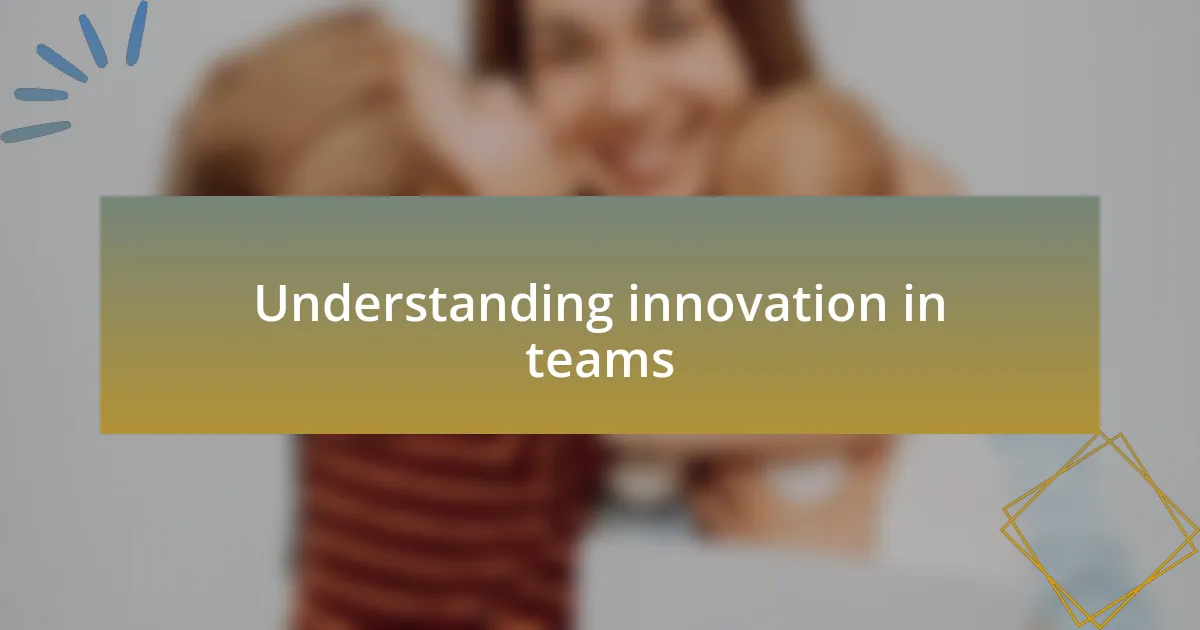
Understanding innovation in teams
Innovation in teams often springs from a strong sense of collaboration and trust. I remember a specific project where we were tasked with revamping our awards show format. We gathered in a room full of ideas and wild concepts, and it became clear that when everyone felt safe to share their thoughts, the most creative solutions emerged. Isn’t it fascinating how an open environment can transform a simple brainstorming session into a breeding ground for original ideas?
The challenge, however, lies in balancing diverse perspectives. There were moments when differing viewpoints clashed, and I found myself asking, “How can we harness these disagreements to spark innovation rather than stifle it?” This realization pushed us to embrace conflict as a necessary part of the creative process. It was amazing to see how, through discussions and compromise, we could refine those ideas into something truly groundbreaking, like integrating audience participation in a new and meaningful way.
Furthermore, I’ve learned that innovation isn’t just about big ideas; it thrives on experimenting and learning from failures. Once, we tried a new voting system based on social media engagement that didn’t go as planned. Instead of treating it as a setback, we analyzed what didn’t work and iterated on it. This experience reinforced my belief that a culture of continuous improvement can lead to unexpected breakthroughs, and isn’t that the essence of innovation?
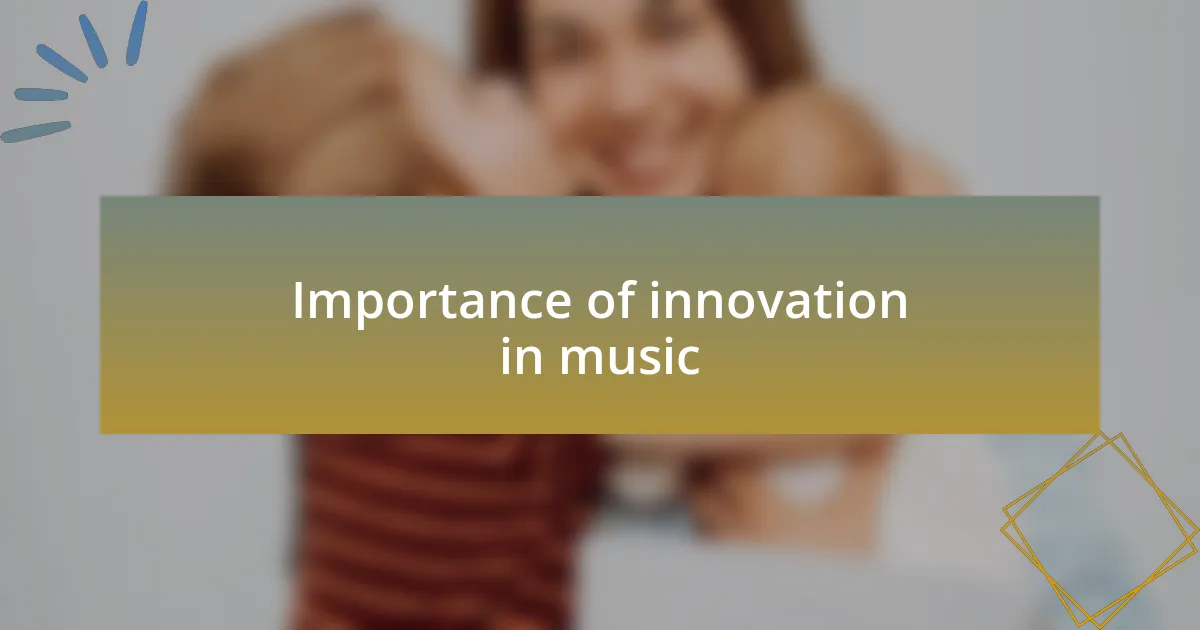
Importance of innovation in music
In the world of music, innovation isn’t just an option; it’s a necessity. I’ve observed that when artists push the boundaries of creativity, they not only expand their own artistry but also inspire others to do the same. For instance, I once attended a concert where the use of technology created a completely immersive experience, altering my perception of live performances forever. Isn’t that what we all strive for—to create moments that resonate deeply and linger in the minds of our audience?
Moreover, the music industry thrives on fresh ideas, shaping genres and redefining trends. I recall a time when a colleague introduced elements from unexpected genres into our event lineup, which not only sparked excitement but also attracted a more diverse audience. It makes me wonder: how often do we limit ourselves by sticking to the familiar? By embracing innovation, we can create a richer tapestry of sound and experience that celebrates diversity in music.
Ultimately, fostering innovation in music cultivates a vibrant community that thrives on collaboration and shared passion. I’ve seen firsthand how artists who collaborate across genres often create groundbreaking works that wouldn’t have existed in isolation. Could it be that by embracing the unconventional, we unlock a wellspring of creativity that propels the entire industry forward? It’s moments like these that remind me of the transformative power of innovative thinking in music.
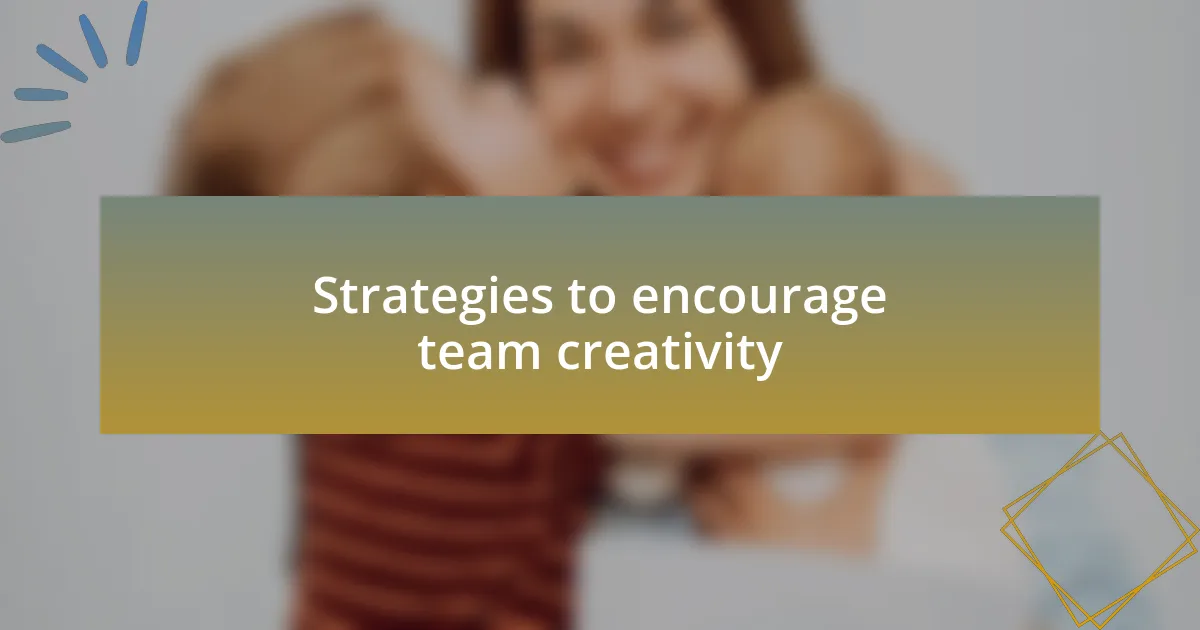
Strategies to encourage team creativity
One effective strategy to encourage team creativity is to create an inclusive environment where everyone feels safe to express their ideas. I remember a brainstorming session where I encouraged my team to discard the fear of judgment, and the response was astonishing—suddenly, the room buzzed with unique ideas that I hadn’t anticipated. It’s fascinating how a small shift in mentality can unlock a flood of creativity.
Another technique that has worked wonders for me is setting aside dedicated time for creative projects. In one instance, I assigned my team a “creativity hour” every week where they could pursue personal music-related passions or try brainstorming new event concepts without constraints. The excitement was palpable, and I witnessed some remarkable innovations emerge from those sessions. What if every team had that luxury? The possibilities could be endless.
Lastly, incorporating cross-disciplinary collaboration can breathe fresh life into creative processes. I once facilitated a workshop where musicians teamed up with visual artists, and the synergy was truly inspiring. It made me realize that great ideas often come from the collision of different perspectives. How often do we miss out on that magic by staying within our comfort zones? By mixing different talents, we not only inspire fresh thinking but also cultivate a culture rich in creativity and collaboration.
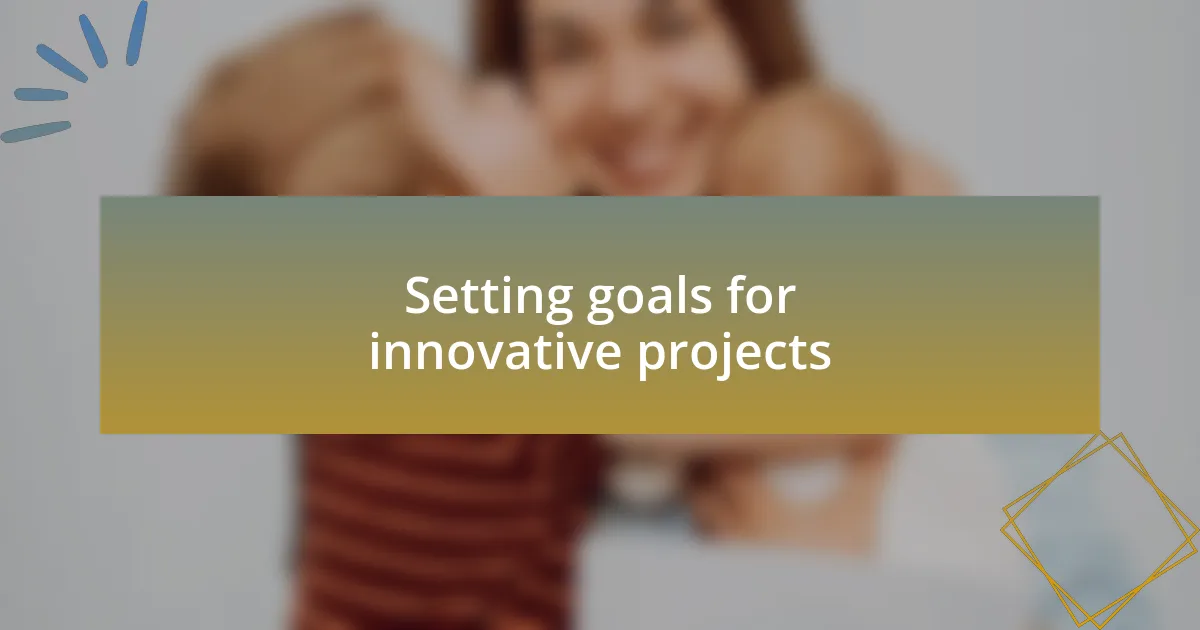
Setting goals for innovative projects
Setting clear goals for innovative projects is crucial for channeling creativity effectively. I once led a project that aimed to revamp our annual music awards show. By breaking down our vision into specific, measurable goals, such as increasing audience engagement by 30% or introducing three new interactive elements, my team had a clear target to hit. It felt empowering to see everyone rally around those objectives, sparking a collective enthusiasm that kept our momentum alive.
It’s essential to be flexible with those goals as well. During the planning phase, I learned that some ideas didn’t fit our original expectations but had the potential for greater impact. For example, when one of my team members suggested an unexpected theme for the awards, we pivoted and embraced it. This adaptability allowed us not only to innovate but also to deeper connect with our audience’s sentiments. Isn’t it amazing how being open to change can lead to breakthroughs?
I always find it helpful to incorporate regular check-ins to assess our progress toward these goals. During those moments, I encourage honest discussions about what’s working and what isn’t. When my team shares both successes and setbacks, it creates an atmosphere of trust. This transparency not only fosters collaboration but also keeps us accountable to our innovative aspirations. Have you ever noticed how a shared journey can ignite passion within a group?
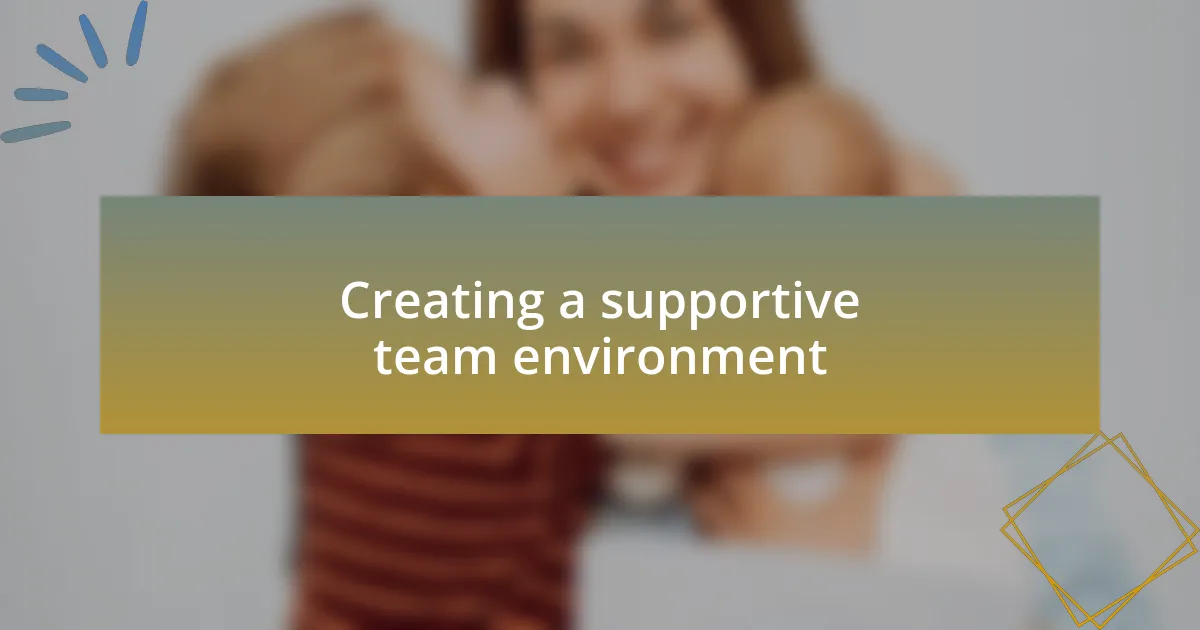
Creating a supportive team environment
Creating a supportive team environment is all about making everyone feel valued and respected. I remember a time when I organized a brainstorming session where every team member was encouraged to share their ideas, no matter how unconventional they seemed. The atmosphere shifted as soon as we put aside our fears of judgment; it was exhilarating to witness those “aha” moments emerge when individuals realized their contributions were taken seriously. Have you ever been in a setting where you felt your voice truly mattered? It can profoundly impact motivation.
To nurture a sense of belonging, I tried to incorporate team-building activities that allowed us to connect outside of the pressures of our daily tasks. On one occasion, we held a casual music trivia night that injected laughter and camaraderie into our routine. This relaxed environment made it easier for team members to collaborate creatively, breaking down barriers that often hinder open communication. When have you found that stepping away from work has helped foster better teamwork?
I strive to make recognition a regular practice within my team. Whether it’s a simple shout-out during meetings or a handwritten note celebrating a job well done, acknowledging individual contributions helps cultivate a culture of encouragement. One particular instance stands out when I praised a team member for their innovative idea that surprisingly became a pivotal part of our show. Seeing their reaction reminded me that small gestures can exponentially boost morale. How do you share appreciation within your team?
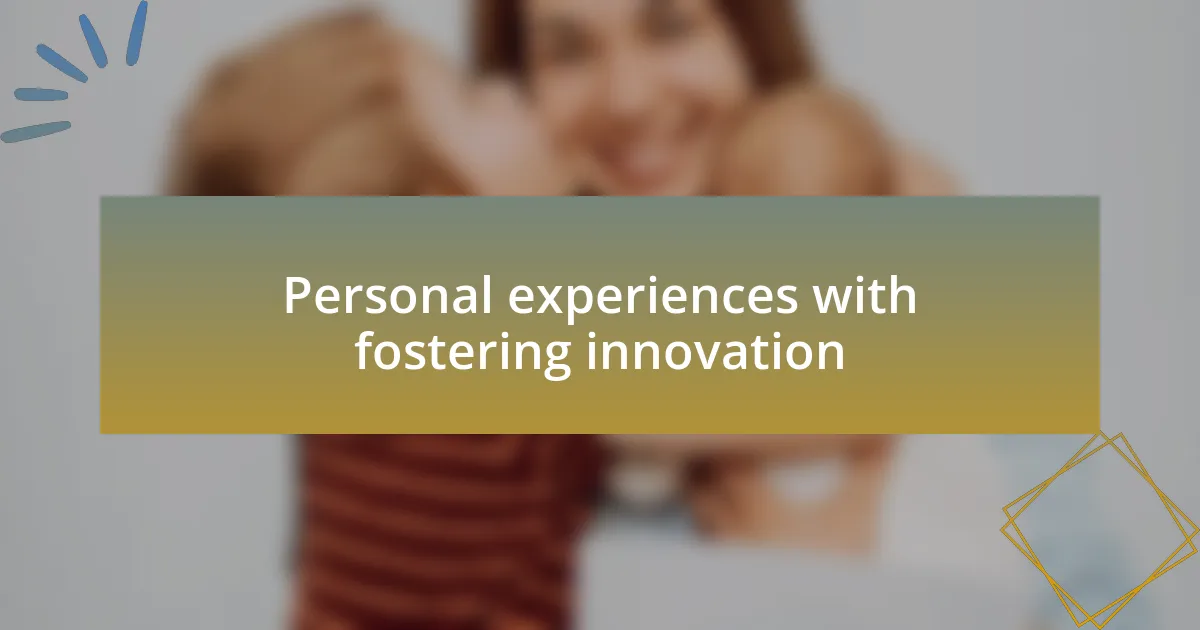
Personal experiences with fostering innovation
Fostering innovation often means taking risks together as a team. I vividly recall a project where we experimented with integrating new technology into our performances. It was a nerve-wracking process; I encouraged my team to submit their wildest ideas. To our surprise, one idea blossomed into a mesmerizing interactive element that received enthusiastic feedback from our audience. Have you ever felt anxious about trying something new that ended up transforming your approach?
In another instance, I introduced “innovation hours” where team members could work on passion projects directly related to our music awards. It was inspiring to see how these hours unleashed creativity. One team member developed a unique digital marketing strategy that not only resonated with our audience but also attracted a younger demographic, significantly improving our outreach. Does giving your team the freedom to explore new ideas help them shine?
I’ve learned that fostering a culture of innovation requires constant encouragement and an openness to feedback. There was a particularly eye-opening moment when one of my team members, hesitant at first, found the courage to voice a concern about our traditional methods. That conversation sparked a collaborative rethink of our approach, leading to fresh and exciting ideas for our next awards ceremony. Have you ever had a simple conversation lead to profound changes in your team’s direction?